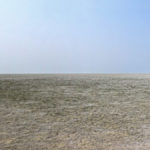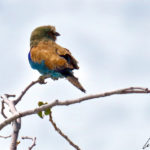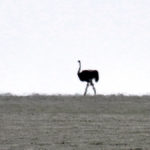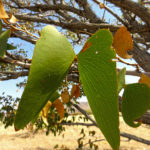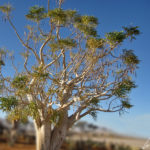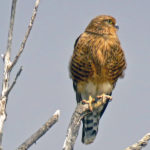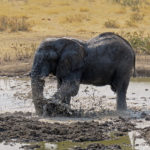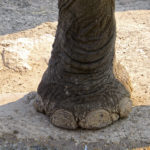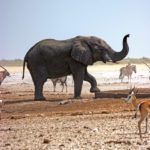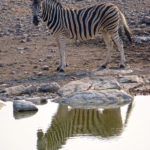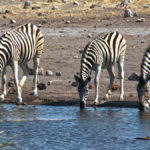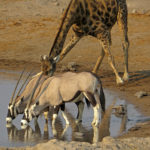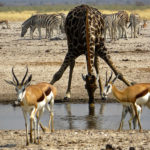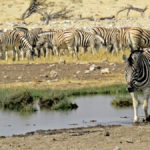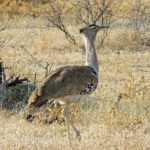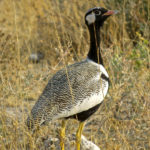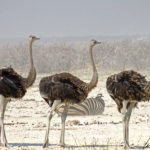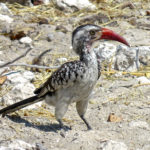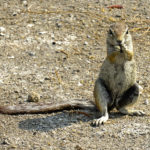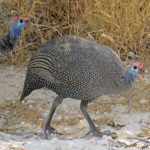Namibia is a marvel for all those seeking distant new horizons… It is unthinkable to go to Namibia without going on a safari! Etosha National Park is one of the largest conservation areas in Africa and one of the best places to observe abundant wildlife roaming freely. The spectacular wildlife can be seen in complete freedom since the park is one of the most accessible animal reserves. You can drive into the park with our own vehicle and move about freely. Created in 1907, Etosha Park in northwestern Namibia is one of the most unique game reserves on the planet, covering an area of 8,600 sq miles. The park is located about 250 miles north of the Namibian capital Windhoek. The Etosha pan, a vast basin of salt, is the emblematic image of the park, although the landscape is much more than that. Imagine vast plains of golden grass crossed by slowly moving herds of zebras and wildebeests. Picture forests of mopanes, shad water holes, a haunted forest, a salt desert as far as the eye can see, savannah landscapes and an impressive concentration of animals. Welcome to the mythical Etosha National Park !
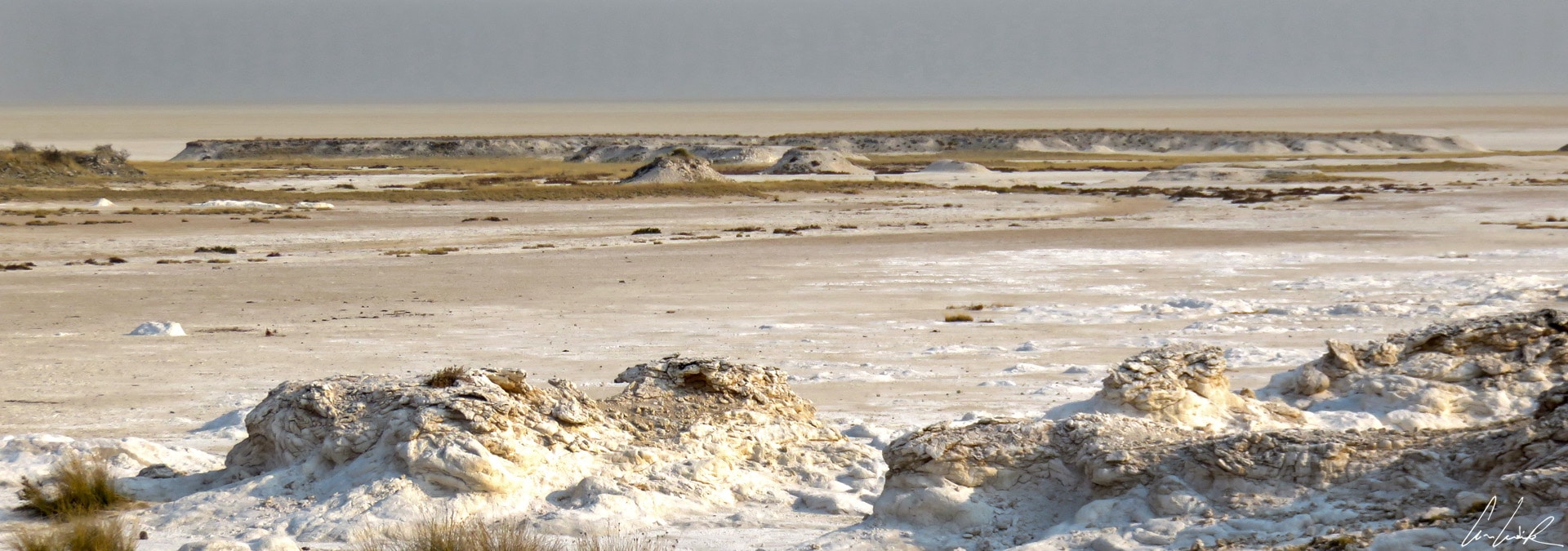
The Etosha pan: a large endorheic salt pan
In Etosha National Park, only the southern area of the Etosha pan is accessible to visitors. This dry salt lake of about 1,840 square miles is the most noticeable geological features of the Park. Swedish explorer Charles Andersson and the Briton Francis Galton discovered the Etosha pan and the surrounding area in 1851. Members of the Owambo tribe accompanied them. The name Etosha came from the Oshindonga word meaning “great white place” in the Owambo language. During the wet season, Africa’s largest salt pan fills with water, creating a green oasis that attracts flamingos and crowned cranes. During the dry season, clay and salt mounds reflect sun’s rays, creating mirages and a surreal setting, pictured in the 1968 science fiction film “2001: A Space Odyssey” produced and directed by Stanley Kubrick. If you look intently at the line of the horizon that runs across the pan where earth and sky meet, eyes concentrated to the extreme,… you see only emptiness! The clay and salt mounds change hue and tone as the sun’s burning rays shift their angle of reflection. The sparkling greyish-white crust of salt crystals extends as far as the eye can see. Even this magnificent lilac-breasted roller perched on a branch sees nothing coming like Sister Anne….
« Anne, Sister Anne, do you see anyone coming ? »
And Sister Anne said: « I see nothing but a cloud of dust in the sun and the green grass »
Bluebeard, in French Barbe Bleue – a French folktale by Charles Perrault published by Barbin in 1697 in the Tales of Mother Goose
From time to time, a wildebeest or ostrich appears on the skyline among the swirls of dust. Fortunately for birds like the roller, predators, in this vast open space, can also be seen from afar !
If the geological formation of this dry salt lake is well known to scientists (erosion, deposits, isostatic uplift, and so forth.) and goes back a few million years, I want add some salt to the story by telling you the local tale of the formation of Etosha pan. A San legend tells that the Etosha pan results from a raid on a village when everyone was slaughtered, except the women. One of the women was so upset by the death of her family, and she cried and cried until her tears formed a vast lake, which eventually dried up and left behind a huge white pan. It is a sad and cute story, right ?

Etosha National Park: Mopane’s Way…
As Marcel Proust wrote in “The Prisoner” published in 1925,
« The only true voyage, the only bath in the Fountain of Youth, would be not to visit strange lands but to possess other eyes, to see the universe through the eyes of another… »
Etosha Park is a first-class animal sanctuary, but in this voyage of discovery it offers the traveler not just new sights, but a chance to see with a new eye? In addition to its rich fauna, the park is home to exceptional flora. The vegetation in Etosha National Park is very diverse with savannah dotted with solitary acacias, vast meadows, and mopane forests called “Omusati” in the local language. This diverse vegetation explains the abundance of wildlife that thrives in the park. Colophospermum mopane, commonly called mopane grows profusely forming woodlands that we can speak of a savannah of mopane. The tree grows in hot, dry areas between 600 and 3,770 feet in elevation. The size of the mopane varies greatly, from a small bush to a tree over 60 feet tall. The tree is easily identified by its distinctive butterfly-shaped leaf or split hooves (everyone has a different imagination) and thin seed pod. The mopane leaves have smell like turpentine, ah, can you smell this pine fragrance floating in the air? The leaves are rich in phosphorus and protein and are one of the elephants’ favorite foods. The hardness of its wood makes mopane termite-resistant. It used in particular for building houses and fences and is also an excellent fuel. As for the seeds, they are pressed to produce essential oil, ground to obtain talcum powder or merely transformed into pearls. Nothing is lost; every part of the mopane has a use! The resins of the bark are also used as varnish or glue while other parts of the tree find medicinal uses (against indigestion, kidney stones, eye inflammation, and other diseases–mopane cures !).

Mopane are more than edible; they are nutritious… even the mopane worms. So let’s open a chapter on local gastronomy! Madora (moth Gonimbrasia belina) is a species of caterpillar…
« Like a butterfly… / like a butterfly… Like a caterpillar / Like an amaranth star / Like a caterpillar / Like a caterpillar / I forget the time I have left / drawn to infinity »
Papillon de nuit by the French singer France Gall
The mopane leaves are a significant source of food for the Madora (or Mopani) caterpillars. These large (up to 3 inches long), colorful and hairy caterpillars are rich in protein and eaten by millions of South Africans. Consumed fresh or dried, ready-to-eat like crackers (yummy, yummy…), these worms can also be cooked, they are often prepared in the simplest of ways, grilled and served with green vegetables! If you are attracted to exotic foods, good appetite….
The Haunted Forest of Moringa
The other botanical curiosity of the park is the African moringa (Moringa ovalifolia) also called the Ghost tree. It is endemic to Namibia and southwestern Angola. It can grow up to 23 feet tall with a trunk diameter up to 40 inches. There is a specially fenced area, about 21 miles west of Okaukuejo (Etosha camp and administrative center) on the road to the Grünewald waterhole called the Moringa Fairy Tale Forest (Sprokieswoud). These trees with strange shapes are often confused with baobabs, but they are not related to the genus Adansonia. The common name in Afrikaans is “spekboom” or “bacon tree,” a name that probably refers to the whitish-grey color of the bark. The local name “meelsakboom” or “floursack tree” derives from the swollen base of the trunk, which looks like a large sack. A San legend explains the strange and sometimes grotesque appearance of Mopane trees by saying that after distributing the animals and plants on earth, God found he had forgotten the moringa trees left alone. He then threw them in a bunch, and they fell back to earth with their roots pointed towards the sky and remained so….
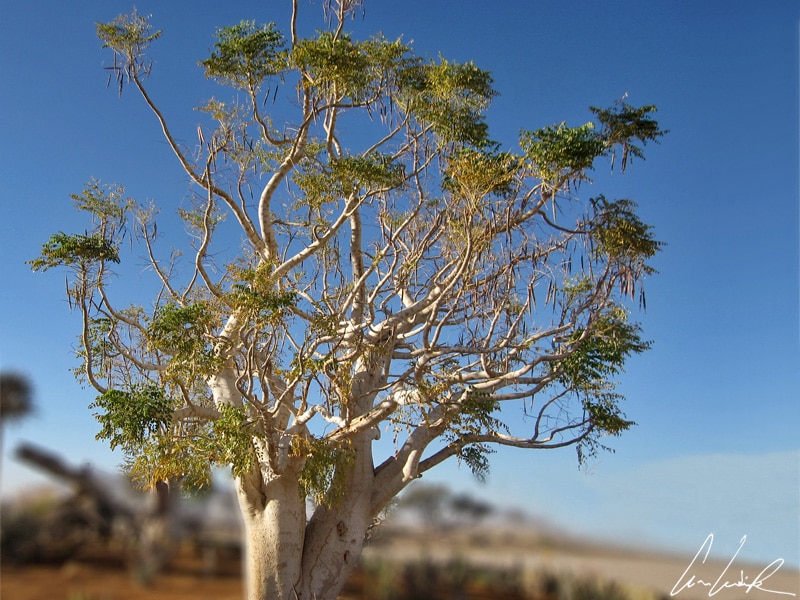
Moringa ovalifolia, a succulent-stemmed tree with a smooth, swollen trunk, is a delicacy for elephants, and pachyderms have destroyed many. They eat the fruit, leaves, and fresh stems. Fortunately, there are still a few specimens on which a white-eyed kestrel or greater kestrel (Falco rupicoloides) is perched ready for hunting. This bird of prey is recognizable by its pale red plumage. It belongs to the falcon family, Falconidae. Perched on the highest branch, it has a 360° view of the surroundings.
Finally, we could not finish this botanical tour of the park without mentioning Terminalia prunioides, a shrub or small tree with long drooping branches that can attain a height of 50 feet. Its leaves grow in clusters on short branches and are between 1 and 3 inches long, the upper part dark green above and the lower pale green. The fruit is about 2 inches long and bright plum in color. The bark and roots have medicinal benefits. The bark is chewed to treat coughs, sore throats and stomach aches. A root preparation is taken to treat constipation, cough, and colds. Local belief gives this species special healing powers, and it is therefore commonly used in rituals by the Herero and Himba peoples.
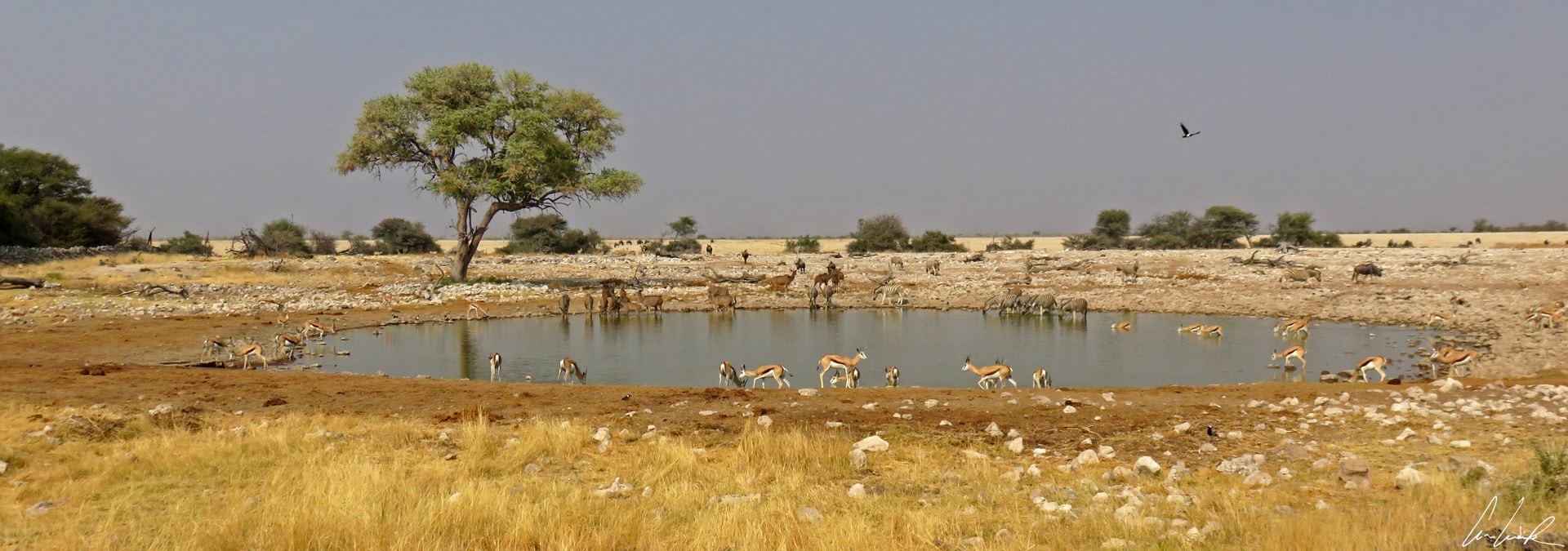
Observation of animals at water holes
Etosha’s water holes are undoubtedly the favorite spots in the park for animals. In winter, when surface water is exhausted, Etosha Park becomes a giant zoo with thousands of animals in search of water, gathering around permanent water holes. In dry periods, the lifestyles, rituals, and habits of animals change: the water point also becomes the center of attraction for people, many people… It is a bit like Times Square in New York or the Champs Elysées in Paris. Sooner or later, everyone from miles away finds his way there! And against all the odds, prey and predators seem to agree to bury the hatchet when it comes to drinking water.
« He spent long hours contemplating the wild animals, especially lions and hyenas that came to drink in small cohorts. These powerful predators, who were usually mortal enemies, observed a truce while they quenched their thirst. In the animal kingdom, water generated peace ».
A l’heure où dorment les fauves by Jean-Baptiste Bester published in 2009
The beauty of a waterhole is the same as that of a safari: you never know what to expect from one minute to the next! There is suddenly this magical moment when all the animals come to drink in a kind of ballet. Since every animal needs water, there are constant trips to and from water holes. The rules of circulation are simple: the strongest always have the right of way… However, the diversity of species drinking at the same time is very surprising.

The ritual of wildlife at water holes
Warthogs wallow in the mud, while elephants frolic and play in the muddy water of a water hole. The elephant with his imposing trunk is probably the best-equipped animal to collect water! The trunk can hold as much as 2.5 gallons of water at one time. Although the elephant requires a considerable amount of water, up to 50 gallons per day, it can go without for three to four days if necessary. This impressive pachyderm has incredible power: look at the legs, the largest in the world, so massive and robust. Elephants can walk up to 15 miles per hour. The elephant can neither run nor gallop: it walks! Their footfall remains that of walking; all four feet never leave the ground at the same time, the mark of running. Elephants continue to drink before our eyes, showering, shaking in the water and slowly spraying themselves with mud. This gives us time to observe these animals in front of the lens of our camera. One of them even takes the time for a photogenic pose worthy of a circus show, before leaving quietly.
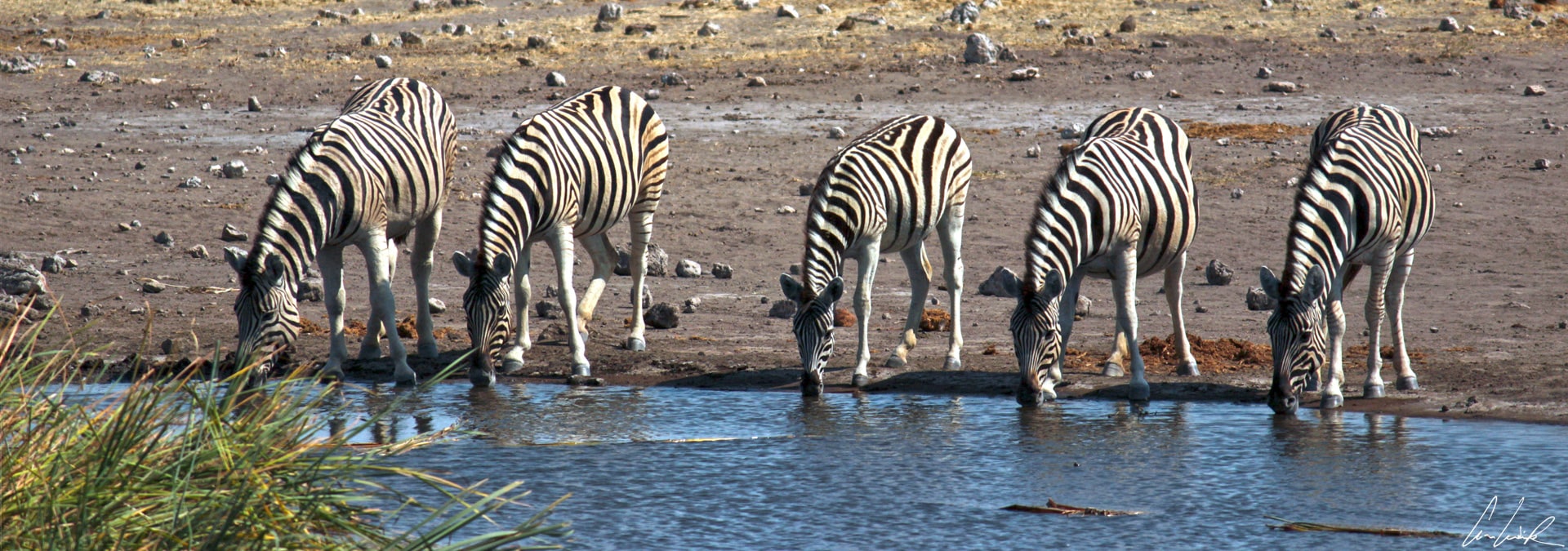
If the elephant can go several days without drinking, the zebra must drink at least once a day. Zebras gather as a family around water holes, and it is usually the female who leads the way.
Animals follow one another again and again to come and drink — Antelopes, including the majestic Oryx share the space with a herd of giraffes. The giraffe sweats little, because its large body which allows the heat to dissipate. The giraffe is extremely resistant to the effects of the heat of the savannah and finds the water it needs in acacia leaves, flowers, and fruits. As a result, the giraffe can go up to a month without drinking. However, when the lady giraffe lady goes to a waterhole to quench her thirst, she has to bend down, lowering her long neck nearly 8 feet, which makes her extremely vulnerable… The excursions to the water points are therefore of short duration. The giraffe’s large, bulging eyes give it an excellent all-round vision from its great height, carefully watching the surroundings to avoid any attack by predators.

Finally, the diversity of birds that frequent the savannah’s Time Square is incredible. We especially enjoy the myriad birds around the water hole in the late afternoon, when the golden light gently colors the setting, making the moment magical. A Kori bustard appears in the middle of a herd of zebras. This bustard is the largest flying bird native to Africa. A very tall bird with an elongated neck and very long legs it seeks its food on the ground by strolling. If Kori bustards feel in danger, they can take off and fly long distances. Some male birds weigh between 15 and 40 pounds making this species undoubtedly the most massive flying bird in the world! One bustard can hide another. Wouldn’t that be a white-quilled bustard in the middle of the dry grass of the savannah? Another bird in the heavyweight category is already approaching… an adult weighs between 140 to 320 pounds depending on the sex. It is a flightless bird, but can run very fast, up to speeds between 35 and 45 mph. Finally, a trio of ostriches arrive together at the water hole.

We witness a real show as Namibian wildlife artists take turns performing. We enjoy seeing the many species of birds that come to drink, swim and fish. By its characteristic “kok-kok-kok-kok-kok-kokok-kokok-kokok-koko” gurgle, we recognize the red-billed hornbill before even seeing its long flaming red curved bill! And now, isn’t that a magnificent Tawny eagle (Aquila rapax), a large bird of prey although is one of the smallest in the genus Aquila? It is about 24-30 inches in length and a wingspan between 63 and 75 inches. The Tawny eagle is mainly carnivorous. Its diet consists of small mammals (rodents) and birds (game birds). If I were a squirrel or guinea fowl from Numidia, I would run away! Vatear! (Help in Herero language).
Find more on Namibia
- Waterberg Plateau Park !
- Lake Otjikoto, a lake that digs its own hole !
- In the heart of the Etosha National Park wildness
- Etosha National Park: A journey to the Animal Kingdom
- Epupa Falls: rendezvous in Himba land
- Encounter with Desert Elephants and Welwitschia Mirabilis
- The Petrified Forest and Rock Carvings of Twyfelfontein
- The Mysterious Skeleton Coast, and Cape Cross’ Fur Seals
- Walvis Bay:Rendezvous with Desert and Ocean

